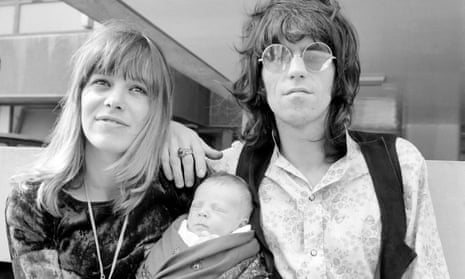In Manhattan in the mid-1990s, Anita Pallenberg would tell her son she was going out for “tea” with Lenny Kaye, the guitarist with the Patti Smith Group. It sounded innocuous enough.
But what the Rolling Stones muse was actually doing was recording what would be transcribed into a memoir found in a shoebox after her death in 2017.
That unpublished memoir – including a childhood in wartorn Germany; an education in Rome; a modelling and acting career that included playing the black queen in Roger Vadim’s Barbarella; her time in the inner circle of the Stones, inspiring Keith Richards to write Gimme Shelter and Mick Jagger to pen You Can’t Always Get What You Want; and an interregnum of addiction and rebirth – has now been made into a film called Catching Fire. The documentary was screened on Friday as part of the BFI London Film Festival, with another showing on Sunday.
“Typical Anita,” says her son, Marlon Richards, executive producer of the film. “You never knew quite what she was up to. She always had a plan – always.” His mum, he supposes with good reason, had no interest in telling her story during her lifetime. Her motto – one taken up by friends including Kate Moss – was “ever forward, don’t explain, don’t complain”.
Unlike some family controlled rock documentaries or biographies that turn out as hagiographies, Catching Fire tells a straight story. Marlon turned over the material to New York film-makers Svetlana Zill and Alexis Bloom. Like a recent book, Elizabeth Winder’s Parachute Women, the film makes the case that beneath the obvious sexism of the music industry there were women who inspired and crafted that creative output. “I couldn’t keep up with Anita,” Keith Richards confirms in the film.
Marlon recalls the time when the family rented the actor Donald Sutherland’s house in Chelsea – one of perhaps 20 they rented through the 60s and 70s in France, Jamaica, Switzerland and elsewhere, often on the run from the law. Here, Richards recorded the album Pay Pack & Follow by John Phillips of The Mamas & The Papas. “I remember my father coming back from recording, being on the staircase, and my mother lobbed a bottle of Ribena at him. Missed him by inches. There was a big purple splat on the wall that stayed there. He retired to the studio and locked the door. To his credit he didn’t react much. He took his beatings.”
The film is constructed from Super-8 film of the Richards’s home life found among Pallenberg’s possessions as well as contemporary reflections from Keith, fellow Stones muse Marianne Faithfull, Moss and others.
Pallenberg brought her mitteleuropa intellect and sophistication to the Stones, informed by her own bohemian bloodlines, including the Swiss symbolist painter Arnold Böcklin, Hungarians, and Prussians including the Brothers Grimm.
“She was more anarchic than hippy – an upsetter, basically,” Marlon says. “At that time, I think, there was very little outlet for women with beauty and intelligence. She enjoyed the power she had over men but also the power she had intellectually.”
The couple made that heritage real with their choice of the marital bed – “a four-poster, dark-wood thing from Transylvania with a secret draw for hiding drugs in when the police came round. Vlad the Impaler-like. A horrible thing, and too small for me…”
It was Pallenberg who’d heard an owl in the trees at home in Sussex that became the woo-woo to Sympathy for the Devil, which Jagger had written from Mikhail Bulgakov’s The Master and Margarita that Faithfull had lent him. And she was the one who had dressed her husband in women’s clothes, although, as her son points out, they were similar in size, living out of suitcases, and with drug addict pre-occupations. “I think he tossed on whatever he could find. I’ve seen him in mum’s blouse on stage. She definitely got him on to the eyeliner. She – and Marianne – changed the face of the Stones at that time, definitely.”
The creative mythology of the band tells how Pallenberg had gone out first with the abusive Brian Jones, then been rescued by Richards on the way to Morocco and struck up a relationship. But that wasn’t the end of it. Richards and Jagger’s girlfriend, Faithfull, knew enough to stay away from the making of Donald Cammell and Nicolas Roeg’s Performance, starring Jagger, James Fox and Pallenberg, often in bed.

The film-set tryst between Pallenberg and Jagger provoked a reaction from Richards. Pallenberg wrote in the memoir, it was silence – “the most frightening reaction of all”. He came back with Gimme Shelter. “It’s now the Vietnam anti-war song, but it’s actually just a love song,” Marlons says.
The four set off on a freighter for South America. In Peru, now without Faithfull but with Pallenberg pregnant with Marlon, Jagger wrote You Can’t Always Get What You Want.
In the early 70s they lived in France, at Villa Nellcôte on the Côte d’Azur in southern France. Richards turned the basement into a recording studio. As the only one who could speak French, Pallenberg found herself managing a house filled with musicians, engineers and hangers-on. And then there was the job of keeping groupies at bay. “Yes, and then there are groupies that have to keep the other groupies at bay, so good luck to them,” Marlon remarks.
“I think she peaked and was exhausted,” says Marlon.
after newsletter promotion
Interludes not included in the film include three weeks in a cell in Jamaica, beaten up by cops and tossed in the men’s cell in a Kingston prison that had held the pirate Henry Morgan.
Later, Anita and Marlon were living in upstate New York, by now isolated from the Stones machine. “By the mid-70s,” he says, “she was pretty high on heroin, pretty fucked up, and truncated – she felt like she’d lost her mojo. She was two children in, sitting at home, and it wasn’t in her character. So she lashed out at everyone.”
Keith meanwhile was on tour, embellishing the renegade imagery. “For him, it’s very attractive. He’s the rock star, and it’s what people want in their gladiatorial sports. They want rock stars to behave like that. They were only junkies for seven or eight years but became the poster people for it.”
Marlon was denied places at schools, and he was taunted. “Fucking drug addicts,” he says. “It’s a toss-up between that and people going, ‘Yeah, your parents are super-cool.’

“It’s hard to blame the Stones, or any of the band members, for what happened. But it does occur – and I’ve seen other women around the Stones become collateral damage. The people in the organisation aren’t really focused on you, they are focused on the band members.”
But that was towards the tail end of the era. In New York, when she was dictating to Kaye (and the biographer Victor Bockris), Pallenberg had come through her darkest years. “That’s when she was firing on all cylinders,” Marlon says, who having graduated from St Martins art college was working at Marc Jacobs fashion.
“That’s the whole thing with heroin, I gather, you start to live from where you left off. So she was 50, but 30 again.” When it came to passing the torch, there was an obvious candidate. When I introduced Anita to Kate [Moss], I thought, ‘Oh god, here we go.’ Kate became like a surrogate daughter.” The lessons included, don’t give a fuck, how to cope with celebrity, use it to your advantage and “be mysterious”, according to Marlon. “I mean, Anita was obsessed with Greta Garbo.” (Towards the end of her life the late New York producer Hal Willner had convinced her to work on an album of Garbo songs.)
If rock’s famous women are now starting to get the credit they deserve, it could be seen at the packed screening of Catching Fire last week.
When Marlon was cleaning out his mother’s flat in London in 2019, he found a Stones greatest hits platinum disc with her name on the plaque. “You have to be very involved to get a platinum record. She’d kept it hidden away in a cupboard. But someone had realised that she’d done something.”
